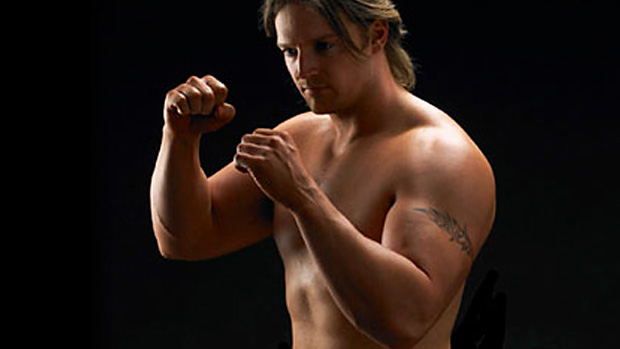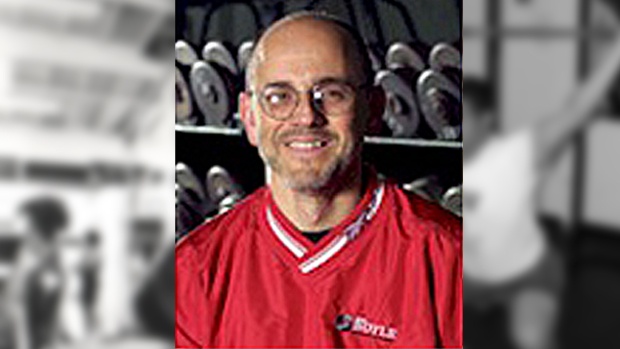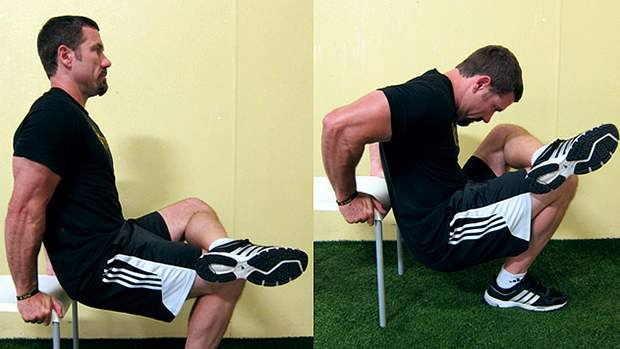I've been in the iron game for about 15 years, and I've learned
a few things about building muscle.
By researching all of the training theories and techniques, and
by trying them out first on myself, then on my clients, I've gotten
a real sense of what works and what doesn't.
Some techniques and strategies (such as working out twice a day
six days a week), while effective, aren't very user-friendly.
Other strategies just plain suck.
And then there are those strategies that are both effective and user friendly. These are what I call the battle-tested
strategies for size and strength, and I'll present five of them in
this article.
The Machine Gun Method (10-set protocol)
This method goes by many names and variations: Charles Poliquin
called his variation German Volume Training, while Vince Gironda
referred to it as 10x10, 8x8 and 15x4. And followers of Pavel
Tsatsouline know it simply as "The Bear."
The strategy works like this: choose one exercise (only one) for each of the muscle groups you want to train and perform
many, many, many sets of it. You would perform anywhere from
8 to 20 sets of the same exercise, although 10 sets total is
typically chosen as the target (hence the name).
This is high volume training at its best. Think of this method
like a machine gun: the first few rounds may maim your target, but
the next 10 to 15 will obliterate it. Even if you don't feel
your muscles within the first few sets, then you'll definitely
feel it within the next ten.
<!--
 |
A deadly and unpredictable weapon, here holding an MP5
submachine gun.
-->
Two things to keep in mind about this protocol. First,
you're more likely to overtrain on high volume (many sets of
many reps) as opposed to high intensity (heavy weight). So use
heavy weight and low reps (3 to 6) for the Machine Gun Method. If
you use higher reps (ten or more), then the total volume will be
too high and you'll overtrain.
Second, you should employ the machine gun method on only a
handful of body parts at a time. If you tried to do 10 to 20 sets
for every muscle, then you'd overtrain from the sheer volume
imposed on your nervous system. Instead, employ the "Shotgun
Method" of choosing exercises:
 |
Arnold often employed the Shotgun Method.
The Shotgun Method
No, I'm not a gun nut, but I do love the firearm analogies.
In this method, you choose exercises that give you the biggest bang
for your buck: the fewest number of exercises that'll
stimulate the most amount of muscle.
We're not talking about bench presses or leg presses, where only
half of your body is involved. We're talking about total body
exercises like the Olympic lifts (clean and press, the snatch,
etc.), deadlifts and squats. These are exercises that induce a huge
dump of Testosterone in your body.
 |
The power clean: more bang for your buck.
Once you've chosen two or three "shotgun" movements, you'll
blast away at them with multiple sets of heavy weight, using the
Machine Gun Method. Then you'll follow up with a few sets of
"troubleshooting" movements. These are exercises that you choose to
address any lagging muscle groups.
The beauty of this strategy is that whenever you employ the
shotgun movements, you create an anabolic response in your body
that might last a week. Within this week you can follow-up with
exercises to take advantage of that pulse of Testosterone and
develop any muscles you feel need some extra
attention.
Here's what a Shotgun Method program looks like:
Workout #1: Shotgun
Clean and press (back, traps, triceps, biceps and
deltoids)
8 sets of 3-5 reps
90-second intervals
Pull-ups (back, biceps, forearms, and deltoids)
8 sets of 3-5 reps
90-second intervals
Deadlifts (quadriceps, hamstrings, back, traps,
forearms)
8 sets of 3-5 reps
90-second intervals
 |
The deadlift: magnum of
excercises.
Workout #2: Troubleshooting
Seated calf raises
3 sets of 10-12 reps
1-minute intervals
Leg extensions
3 sets of 10-12 reps
1-minute intervals
Leg curls
3 sets of 6-8 reps
1-minute intervals
20-degree dumbbell press
3 sets of 6-8 reps
1-minute intervals
Seated cable rows
3 sets of 6-8 reps
1-minute intervals
Dumbbell laterals
3 sets of 10-12 reps
1-minute intervals
Incline curls
3 sets of 6-8 reps
1-minute intervals
Lying dumbbell extensions
3 sets of 6-8 reps
1-minute intervals
The Heavy/Light Method
This is a solid strategy to follow in your quest for size and
strength. It's simple but complete, versatile and effective.
The heavy/light strategy goes like this: perform heavy sets to
develop strength and muscular density, then perform light pumping
sets to increase blood flow and capillary development. Hence, you
develop both sarcomere and scarcoplasmic hypertrophy in your
muscles.
The heavy/light method can be performed in many
ways:
Consecutive Sets of Heavy/Light
In this variation, you perform a series of heavy sets for a body
part, and then follow them up with a series of light sets for the
same body part. For example:
Sets 1-4: 4-6 reps
Sets 5-7: 10-12 reps
You can use the same exercise for both rep ranges or two
different exercises.
The Heavy/Light Compound Set
In this variation, you perform a set of low reps and heavy
weight for a body part, then immediately perform a set of higher
reps with lighter weight with a different exercise targeting the
same body part. An example of this would be 6-8 reps for the bench
press followed by 10-12 reps of pushups.
Cross Wiring
This is where you intersperse light sets with heavy sets, using
the same exercise (also known as wave loading or series training)
or with different exercises for the same body part. Typically, in
cross wiring two exercises, you alternate between a compound
movement and an isolation movement:
1A: Barbell Military Press
3-5 reps
90-second intervals
1B: Dumbbell laterals
12-15 reps
90-second intervals
Repeat three more times
Set Extenders
Set extenders are techniques that allow you to go beyond a
normal set for a given muscle group. Techniques like rest-pause,
compound sets, tri-sets, and descending sets are all set extenders.
The reason these techniques work so well is that they allow you to
serve two masters: volume and intensity.
Say you perform 4 to 6 reps at a given weight. The intensity
(weight) is high, but the volume (reps) is low. If you performed 10
to 12 reps, then the volume would be high, but intensity would be
low.
With set extenders, however, you increase both volume and
intensity. When you can increase both volume and intensity, then
you increase muscular hypertrophy.
Let's take tri-sets, for example. Suppose you can do pull-ups,
but you can only perform 4-6 reps. You can extend the set for your
back by doing a tri-set such as this:
Pull-ups (4-6 reps)
Lat bar cable rows (6-8 reps)
Wide grip deadlifts (4-6 reps)
Instead of just doing a set of 4 to 6 reps, you've now done a
triset of 14-20 reps for the back. This is a great way to add extra
exercises without overextending the length of your
workout.
Other set extenders to consider:
Rest-pause
This is an excellent technique for those who are fast-twitch
monsters. If you respond best to heavy weight, then this technique
will help you fully develop your fast-twitch muscle fibers. Simply
do as many reps as you can with a given weight and put the weight
down. Rest 10 seconds and resume the set. Rep out and repeat once
more.
Descending sets
Whereas rest-pause works best for fast-twitch muscles,
descending sets work best for slow-twitch muscles, such as the
lateral head of the deltoids and calves. This technique also works
best in a commercial gym, where you can easily implement it on a
dumbbell rack or a cable machine.
Compound sets
This is when you perform two exercises in a row for one body
part (which is different from a superset, where you alternate
between sets of two body parts). Compound sets can be implemented
in two ways:
The Post-Exhaust Compound Set - You've no doubt heard of the
pre-exhaust method. The post-exhaust compound set is the exact
opposite. Post-exhaust requires that you perform a multi-joint
movement for a body part followed by a single-joint movement for
that same body part. An example of this would be a pull-up followed
by stiff-arm pulldowns.
The Heavy/Light Compound Set - As I mentioned earlier, this is
where you perform low reps with heavy weight for one exercise, then
immediately perform higher reps with a lighter weight of another
exercise. The heavy/light method can be combined with the
post-exhaust method: front squats (4-6 reps) followed immediately
by leg extensions (10-12 reps).
Back Cycling: Controlled Overtraining
"Back cycling" is a training strategy where you purposely
overtrain yourself for a short period of time and then pull back to
allow your body to overcompensate with muscular growth.
Bodybuilders had played around with the concept since the early
days, but no one had promoted it as a training strategy until Leo
Costa and Russ Horine promoted it in the late 1980's and
1990's.
Back cycling is not the same as "muscle confusion," which is
simply a haphazard changing of routines without rhyme or reason.
Back cycling is best described as "controlled overtraining."
You purposely increase the densityof training for a short
period of time, anywhere from three days to three weeks. In other
words, you do more work per unit of time. This means increased
sets, reps, and exercises per workout, but the workout length will
remain the same: 45-60 minutes. To pack in more sets, reps and
exercises within this brief time frame, you must employ shorter
rest periods and possibly use set extenders as well. Think of it as
putting your body into overdrive.
You can't stay in overdrive forever, of course. If you go
beyond three weeks, you'll surely overtrain. This is when you
have to pull back or "back cycle." Rather than focus on training
density, you'll decompress the volume and focus on training intensity. This means heavier weight, lower reps, higher
rest periods and fewer sets and exercises.
Here's a back cycling routine using both the classic 10x10 and
5x5 methods:
Week 1-3 (Density)
10 sets of 10 reps with 1 minute rest periods
One exercise per muscle group
8 muscle groups (Chest, Back, Deltoids, Biceps, Triceps, Quads,
Hamstrings, Calves)
Week 4-6 (Decompression)
5 sets of 5 reps with 3 minute rest periods
One exercise per muscle group
5 muscle groups (Chest, Back, Quads, Hamstrings,
Calves)
If you look closely, the 10x10 method has greater training
density than the 5x5 method. You're doing four times as much volume
per muscle group with shorter rest periods:
10x10=100 reps vs. 5x5=25 reps
The 5x5 method, however, has greater intensity, since you're
focusing on heavier weight with fewer exercises. Despite the
greater intensity, you're pulling back from training density by
employing longer rest periods (3 minutes).
"Plan Your Workout. Work Out to Your Plan."
Now that I've shown you some battle proven strategies for size
and strength, go out there and kick some ass in the gym. Train
smart and stay safe.





